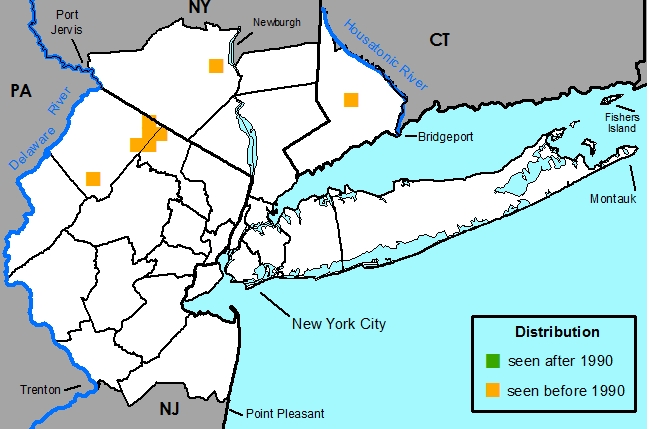Lonicera canadensis Bartr. - Fly Honeysuckle, Medaddy bush
Common Names
Fly Honeysuckle, Medaddy bushField Identification
Deciduous shrub with opposite, entire-margined leaves; light yellow flowers followed by orange-red berries.Medicinal uses
Disclaimer: The information provided here is for reference and historical use. We do not recommend nor do we condone the use of this species for medicinal purposes without first consulting a physician.Used by Native Americans to treat venereal diseases, urinary disorders, and "homesickness"; and used as a diuretic, blood purifier, and sedative.
Poisonous properties
Disclaimer: The information provided here is for reference and historical use. If you believe you have been poisoned, please contact the Poison Control Office near you (look for the number in the front of the phone book).
Although the berries of some species are known to be edible; generally, ingestion of the fruit causes mild to moderate nausea, vomiting, and diarrhea; death is unlikely.
Nomenclature
Lonicera canadensis Bartr., Cat. Am. Trees Bartram's Gard. Broadsheet, col. 3. 1785.Xylosteum tataricum Michx., Fl. Bor.-Am. 1: 66. 1803, non Dumont de Courset 1802.
Lonicera ciliata Muhlb., Cat. Pl. Am. Sept. 23. 1813.
Xylosteum ciliatum Pursh, Fl. Am. Sept. 1: 161. 1814.
Caprifolium ciliatum Kuntze, Rev. Gen. Pl. 1: 274. 1891.
TYPE: unknown
Description
HABIT Perennial, deciduous, phanerophytic, shrub, monoclinous, 1-2 m tall.STEMS Main stems ascending or erect, round. Bark furrowed or fibrous, not exfoliating, light brown. Branches ascending or horizontal. Twigs light brown, terete, 1.5-4 mm in diam., smooth, glabrous, becoming stringy on older twigs. Pith white, round, continuous, nodal diaphragm absent. Sap translucent. For a detailed analysis of the root anatomy see Gasson, 1979
BUDS Terminal and axillary present, scattered along stem; axillary buds 1-2 per axil, ovoid, often superposed. Bud scales brown, imbricate, glabrous. Bud scale scars not encircling the stem. Leaf scars thinly crescent-shaped. Vascular bundle scars 3.
LEAVESOpposite, simple, spaced somewhat evenly along and divergent from stem. Stipules absent. Leaves petiolate, petiole flattened, 0.4-0.8 cm long, with long and unbranched erect or spreading hairs sparsely distributed marginally; not glabrescent. Leaf blades: abaxial surface light green, adaxial surface green, oblong or ovate or widely deltate, bilaterally symmetric, 2-10 cm long, 1.5-5.5 cm wide, base cuneate or obtuse or cordate, margin entire or ciliate, apex acute, abaxial surface usually glabrous or with long and unbranched white hairs, sparsely distributed throughout. Adaxial surface glabrous.
INFLORESCENCESSerotinous, formed on last season's growth, bisexual, simple, 2-flowered axillary cyme. Peduncle 1.5-2.5 cm long, drooping, glabrous. Rachis absent. Bracts sessile, light greenish yellow, linear triangular, 1.5-2.5 mm long, 0.5 mm wide, margin entire, apex acute, surfaces glabrous. Flowers sessile at peduncle apex. Bracteoles often obsolete or 1 or 2, elliptic, margin entire, apex obtuse, glabrous.
FLOWERSSepals and petals readily distinguishable from one another, 5-merous, 2 flowers per inflorescence. Calyx actinomorphic, of fused sepals, persistent. Sepal lobes 5, shallowly triangular, margin entire, apex obtuse, glabrous. Corolla actinomorphic, infundibuliform, of fused petals, deciduous, abaxial and adaxial surfaces light yellow or white, 15-20 mm long, saccate at base. Petal lobes 5, margin entire, apex obtuse, abaxial surface glabrous; adaxial surface glabrous. Gynoecium syncarpous. Locules 2-3. Stigmas 1, capitate. Styles 1, slightly exserted. Ovary inferior, glabrous. Placentation axile. Androecium epipetalous, included, haplostemous, inserted near the top of the corolla tube. Stamens 5. Anthers opening along the long axis, glabrous. Filaments straight, glabrous. For a detailed analysis of the flower micro-anatomy and vascularization see Wilkinson, 1948
FRUITS Bacca, red, ovoid, 8-12 mm long, 6-8 mm wide, glabrous.
SEEDS Seeds 1 or 2, orange-red or brown, ovoid, 3.5-4 mm long, 2-2.5 mm wide, glabrous.
Habitat
Dry to moist upland woods, sometimes along streams.Distribution
Native to northeastern North America.
United States -- CT, GA, IA, IL, IN?, KY?, MA, MD, ME, MI, MN, NC, NH, NJ, NY, OH, PA, TN, VA, VT, WI, WV
Canada -- NB, NS, ON, PE, QC New York
Metropolitan Region -- Native, restricted to northern and western upland areas in the metropolitan flora.
Rarity Status
Heritage global rank -- G5Connecticut -- Not listed
New Jersey -- S1
New York -- Not listed
Species Biology
Mellitophily -- Andrena, Bombus, Halictus, Osmia
Endozoochory -- Avian frugivores: Bonasa umbellus (Ruffed Grouse), Turdus migratorius (Robin), Catharus minima (Gray-cheeked Trush), Catharus ustulatus (Swainson's Thrush), Dumetella carolinensis (Gray Catbird), Bombycilla cedorum (Cedar Waxwing), Cardinalis cardinalis (Cardinal), Carpodacus purpureus (Purple Finch), Carduelis tristis (Goldfinch), Zonotrichia albicollis (White-throated Sparrow), Mimus polyglottus (Mockingbird), Dendroica coronata?(Yellow-rumped Warbler), Toxosoma rufum? (Brown Thrasher), Cyanociita cristata? (Blue Jay)
Natural germination is believed to occur in the spring following autumn/winter dispersal. This species apparently has little or no seed dormancy. Germination is epigeous. While definite information for the optimum storage of Lonicera seeds is lacking; generally, seed stored in a sealed container at 41 degrees F should remain viable for at least one year.
